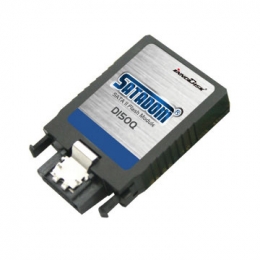InnoDisk Serial ATA Disk on Module supports SATA II standard (3.0Gb/s) interface with good performance and
thus performs faster data transfer rate. Sustain read can reach up to 125MB per second (max), and sustain
write reach up to 120MB per second (max). Moreover, InnoDisk SATADOM D150QV is designed as the
smallest form factor size that could enhance compatibility with various design applications. Particularly the 7th
pin of standard SATA 7pin connector can optionally be the built-in power VCC pin. In other words, it could be
connected directly to the SATA on-board socket on customers’ system without additional power cable. Another
advanced design of InnoDisk SATADOM D150QV is the connector with latch and thus such innovative
mechanical design could improve data transfer reliability while device operating. With the locked connector
design, it could enhance anti-vibration mechanism.
Besides, the booting time for operation and the power consumption is less than hard disk drive (HDD).
InnoDisk SATADOM D150QV can work under harsh environment compile with ATA protocol, no additional
drives are required, and the SSD can be configured as a boot device or data storage device.
InnoDisk SATADOM D150QV support SATA II interface, and compliant with Serial ATA Gen 1 and Gen 2
specification (Gen2 supports 1.5Gbps /3.0Gbps data rate).
Burst Transfer Rate : 3.0 Gbps
16GB~32GB
Sustained Read: 125MB/sec (max.)
Sustained Write: 120MB/sec (max.)
8GB
Sustained Read: 90MB/sec (max.)
Sustained Write: 75MB/sec (max.)
4GB
Sustained Read: 90MB/sec (max.)
Sustained Write: 40MB/sec (max.)
2GB
TBD
Highly sophisticated Error Correction Code algorithms are implemented. The ECC unit consists of the Parity
Unit (parity-byte generation) and the Syndrome Unit (syndrome-byte computation). This unit implements an
algorithm that can correct 16 bits per 512 bytes in an ECC block. Code-byte generation during write operations,
as well as error detection during read operation, is implemented on the fly without any speed penalties.
Flash memory can be erased within a limited number of times. This number is called the erase cycle limit or
write endurance limit and is defined by the flash array vendor. The erase cycle limit applies to each individual
erase block in the flash device.
InnoDisk SATADOM D150QV uses a static wear-leveling algorithm to ensure that consecutive writes of a
specific sector are not written physically to the same page/block in the flash. This spreads flash media usage
evenly across all pages, thereby extending flash lifetime.
InnoDisk SATADOM D150QV within the write-protect function could prevent the device from modification and
deletion. Write-protected data could only be read, that is, users could not write to it, edit it, append data to it, or
delete it. When users would like to make sure that neither themselves nor others could modify or destroy the
file, users could switch on write-protection. Thus, InnoDisk SATADOM D150QV could process write-protect
mechanism and disable flash memory to be written-in any data. Only while the system power-off, users could
switch on write-protection. Write-protection could not be switched-on, after OS booting.
Read Cycles: Unlimited Read Cycles.
Write /Erase Cycles: 2,000,000 Erase Cycles.
Data Retention: 10 years.
Wear-Leveling Algorithm: support.
Bad Blocks Management: Support
Error Correct Code: Support
MTBF > 4,000,000 hours
SATADOM D150QV with Pin7 VCC, it is defined Pin7 as VCC on the SATA connector. Thus the power would
come from SATA connector Pin7 VCC. Customers DO NOT have to use the power cable for power supply.
Such a wireless design of SATADOM D150QV with Pin7 VCC brings more convenience to customers’ system.
The followings are the points customers have to be careful of while designing in SATADOM D150QV with Pin7
VCC.
SATADOM D150QV with Pin7 VCC is designed with a fuse (polyswitch 500mA, 6V) on Pin7’s circuit. Such a
design could avoid any potential damage to customers’ system.
When customers use SATADOM D150QV with Pin7 VCC, but the Pin7 of SATA socket on customers’ system
is ground pin, the device could not be recognized.
To have the advantages of SATADOM D150QV with Pin7 VCC, and to avoid any potential damage to
customers’ board designed with VCC power supply, InnoDisk suggests that customers MUST design their
board with a fuse which should be designed before the SATA socket Pin7 VCC. In other words, customers are
suggested NOT TO layout 5V VCC to SATA socket on board directly. A circuit diagram example to explain this
is shown as below.
|
